![]()
![]()
![]()
Use LEFT and RIGHT arrow keys to navigate between flashcards;
Use UP and DOWN arrow keys to flip the card;
H to show hint;
A reads text to speech;
65 Cards in this Set
- Front
- Back
|
Coordination |
Ability to make appropriate responses to internal amd external stimuli |
|
|
Pathway of response |
Stimulus (light, sound) > receptors (eyes, ears) > sensory nerve > coordinator (brain, spinal cord) > motor nerve > effector (muscles, nerves) > response (movement, secretion) |
|
|
Organization of the nervous system |
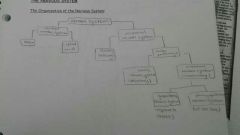
|
|
|
Neurons |
Functional unit of the nervous system |
|
|
Neuroglial cells |
Provide physical and physiological support for the neurons |
|
|
Sensory neurons |
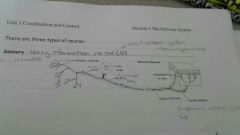
- carry info to the CNS - cell body in the middle |
|
|
Motor neuron |

Carry info to the effectors - cell body at one end |
|
|
Interneurons |
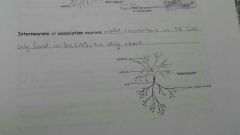
Make connections in the CNS - only found in the CNS - very short |
|
|
Cell body |
The part of the neuron that contains the cell's organelles. Most cellular functions occur here. |
|
|
Dendrites |
Gather information and send a nerve impulse towards the cell body |
|
|
Axon |
Sends a nerve impulse away from the cell body towards other neurons or effectors |
|
|
Myelin sheath |
Fatty, insulating layer |
|
|
Schwann cells |
Forms myelin and grow around the axon |
|
|
Nodes of Ranvier |
Gaps found between adjacent sections of the myelin sheath |
|
|
Mylenation |
Speeds up nerve connection - aids in neuron regeneration |
|
|
Neurolemma |
Delicate nucleated membrane that covers nerve fibres of the PNS - promote regeneration of nerve fibre after trauma |
|
|
Nerve pathways |
How neurons are connected Simplest: reflexes |
|
|
Reflex |
Automatic responses to sensory stimuli - involuntary |
|
|
Reflex arc |
Pathway of neurons that are involved |
|
|
Synapse |
Gap between neurons |
|
|
Neurotransmitters |
Carry nerve impulses across synapses |
|
|
Electrochemical nature |
Wave of charges in electrical potential |
|
|
Resting potential |
Resting state > membrane is negatively charged internally with respect to the outside at a potential difference of -70 mv - polarized |
|
|
Sodium/potassium pump |
Actively transport sodium OUT of the axon and potassium INTO the axon |
|
|
Action potential |
Stimulation of the neuron by electrical discharge causes the axon membrane to pass through the membrane into the axon - reverses that membrane potential from -70 mv to +40 mv - depolarized |
|
|
Re-polarization |
Once the sodium is in the membrane the "gate" closes but the membrane becomes permeable to potassium (go out of the axon) - sodium and potassium are on the wrong sides of the membrane - sodium/potassium pumps exchange sodium and potassium to resting potential |
|
|
Refractory period |
- until the resting potential is properly restored another action potential cannot be conducted - time for it to occur = refractory period |
|
|
Absolute and relative refractory period |
Absolute - 1ms when no impulse will pass Relative - further 5ms when a strong impulse will pass |
|
|
Threshold level |
The stimulus has to be intense enough to cause depolarization - once threshold is exceeded depolarization will occur |
|
|
All or none response |
Increasing the level of stimulus won't produce a greater level of depolarization or increase the speed of nerve impulse conduction |
|
|
Effectors of the speed of nerve impulses |
1. Diameter of axon (greater = faster) 2. Presence of myelin (myelinated neurons conduct impulses much faster) |
|
|
Acetylcholine |
Most common neurotransmitter |
|
|
Acetyl cholinesterase |
Breaks down acetylcholine to choline and acetic acid - Actively re-absorbed into the pre-synaptic neuron > used to regenerate acetylcholine |
|
|
Function of synapses |
Ensures they work in the right direction - control the flow of information |
|
|
Divergence |
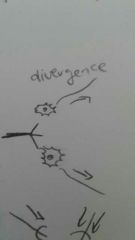
Information is passed to more than one area at a time |
|
|
Convergence |
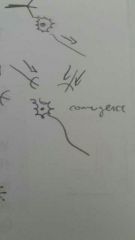
Response to more than one source of stimulus |
|
|
Summation |
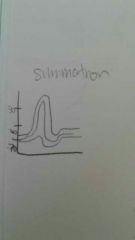
Arrangement to have more than one neuron "fire" impulses to stimulate the polysynaptic neuron |
|
|
Parkinson's disease |
Deficiency of dopamine |
|
|
Alzheimer's disease |
Deficiency of acetylcholine |
|
|
Somatic nerves |
carry sensory information from the receptors to the CNS and motor information to the muscles that are under conscious control |
|
|
Autonomic Nerves |
motor nerves that regulate the involuntary activities |
|
|
Autonomic nervous system |
self-regulating system - controls the unconscious activities of the body particularly associated with stress of relaxation |
|
|
Sympathetic system |
stress (body) - stimulatory |
|
|
Parasympathetic system |
relaxation (face) - inhibitory |
|
|
Ganglia |
synapses in gathered bunches |
|
|
Differences between parasympathetic and sympathetic |
Parasympathetic: ganglia close to the effector - pre-ganglionic are long - post-ganglionic are short - acetylcholine throughout - inhibitory and for relaxation Sympathetic: ganglia close to CNS - pre are short - post are long - acetylcholine pre-ganglionic - stimulatory and preparation for stress |
|
|
Cerebellum |
controls muscle coordination and balance - limb movements, balance, muscle tone |
|
|
Medulla Oblongata |
controls subconscious activities (heart rate, blood pressure, etc) - connects the PNS and CNS, regulates involuntary muscle movements |
|
|
Pons |
relays information between the cerebellum and cerebral cortex - "bridge" |
|
|
Mid-brain |
receives specific sensory input; connects the hindbrain to the forebrain - relay centre for visual and auditory info |
|
|
The Reticular formation |
filters sensory stimulus between conscious and unconscious; responsible for wakefulness - extends into the pons and medulla |
|
|
The Hind-brain |
- back - most primitive part of the brain |
|
|
Thalamus |
connects various parts of the brain; relays information from the senses - sensory signals |
|
|
Hypothalamus |
regulates the pituitary gland (heart rate, blood pressure,and temperature) - homeostasis - connection to pituitary |
|
|
Pituitary Gland |
secretes hormones |
|
|
Cerebrum |
conscious thought - intellect - memory - consciousness |
|
|
Brain Stem |
midbrain, pons, and medulla - controls and integrates the most basic functions |
|
|
Corpus Callosum |
connects left and right hemispheres |
|
|
Cerebral Cortex |
outer layer of cerebrum, sensory processing area |
|
|
Meninges |
Dura mater: outer Arachnoid: middle Pia mater: inner |
|
|
Frontal Lobes |
associated with conscious thought, intelligence, memory,and personality; control voluntary muscle movements |
|
|
Temporal Lobes |
involved in auditory reception |
|
|
Parietal Lobes |
receive sensory information from the skin, and process information about body position |
|
|
Occipital Lobes |
process visual information |
|
|
Spinal Cord |
Grey Matter: unmyelinated White Matter: myelinated Nerve Tracts |

